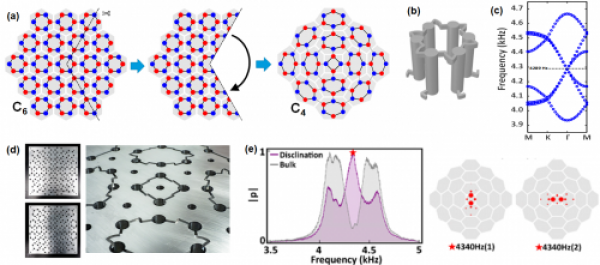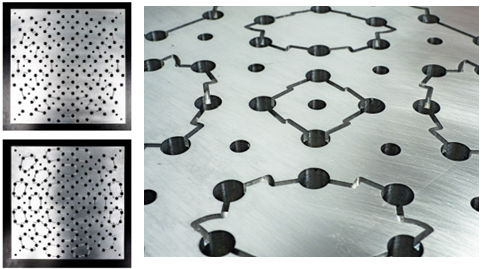[Publication] Observation of degenerate zero-energy topological states at disclinations in an acoustic lattice
This paved the way towards new efficient approaches for robust wave transport and confinement. Furthermore, building upon the bulk-boundary correspondence in topological phases, disclinations haverecently been harnessed to trap fractionally quantized states in classical wave systems.
The figure (a) shows a disclination constructed from a hexagonal lattice using the Volterra process by cutting out a portion with a precise angle (120 degrees here) and “gluing” the ends together while deforming the lattice.
Although this lattice displays states localized at the center of the disclination, such states are not protected from deconfinement due to the breaking of chiral symmetry. This generally leads to resonance modes with short lifetimes and sub-optimal confinement.
In this work the researchers have constructed a phononic with disclination modes while preserving the chiral symmetry.
The phononic crystal is made of closed cylindrical cavities connected by tubes to ensure the coupling between these cavities (figure (b)). A judicious control of the couplings via the geometrical parameters of the tubes ensures the preservation of the chiral symmetry which is manifested by a perfect symmetry of the bands with respect to the central frequency 4289Hz (figure (c)).
The experimental realization of the structure (figure (d)) showed the presence of degenerate acoustic modes in the disclination at the center of the acoustic bandgap, which ensures protected confinement (figure (e)).
This study provides a fresh perspective about the interplay between symmetry protection in topological phases and topological defects, with possible applications in classical and quantum systems alike.

Title: Observation of degenerate zero-energy topological states at disclinations in an acoustic lattice
Authors: Y. Deng, W. A. Benalcazar, Z.-G. Chen, M. Oudich, G. Ma, and Y. Jing.
Journal: Physical Review Letters
Date of publication (online): 26 avril 2022
Link: https://doi.org/10.1103/PhysRevLett.128.174301
Image caption:
(a) Disclination created by the Volterra process
(b) Acoustic unit cell made of closed cylindrical cavities connected by tubes to ensure their coupling
(c) Band structure with perfect symmetry of the bands with respect to the central frequency 4289Hz
(d) Experimental realization of the structure
(e) Measurement of the acoustic pressure in the cavities showing the acoustic degenerate modes confined in the disclination

